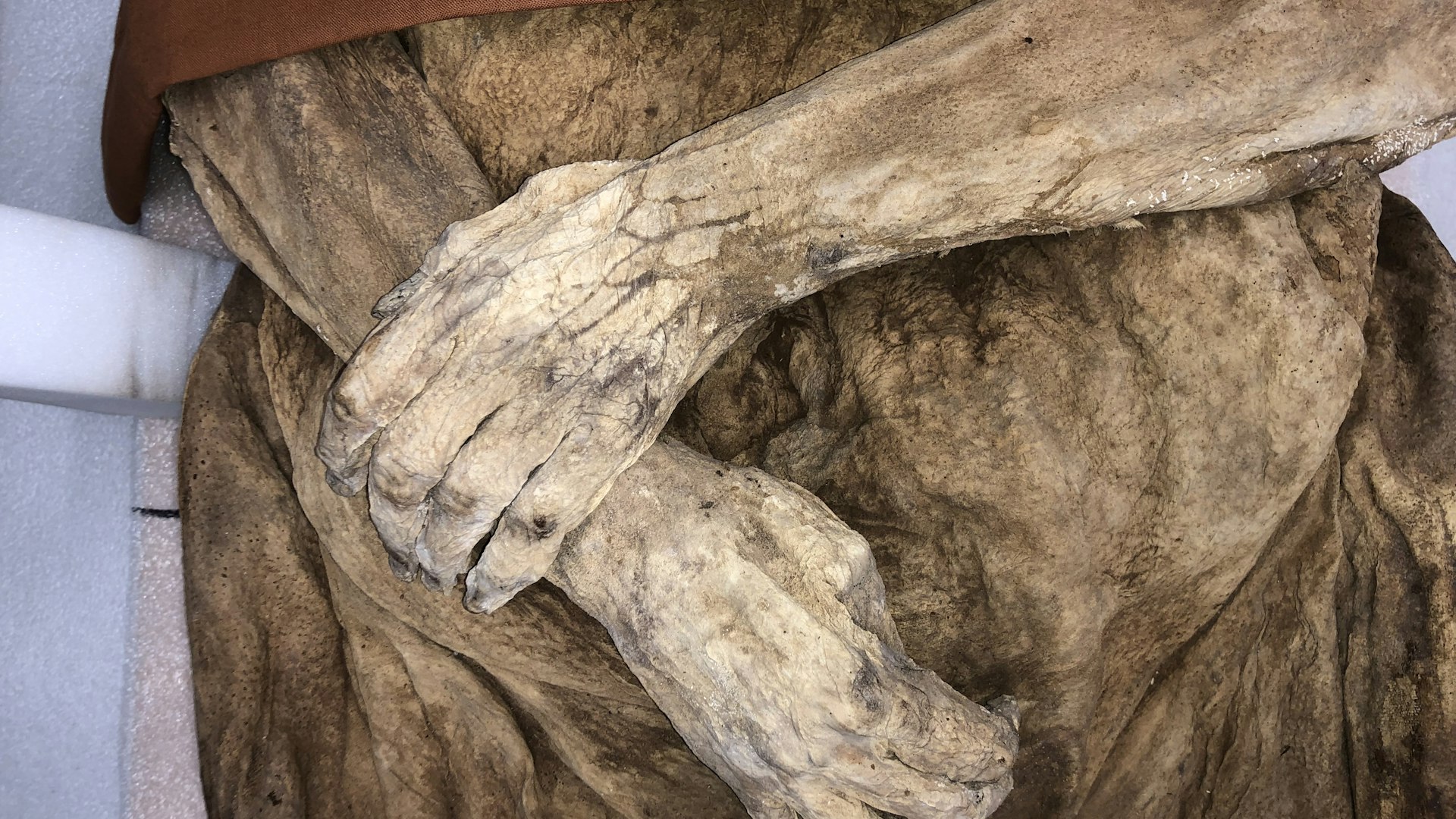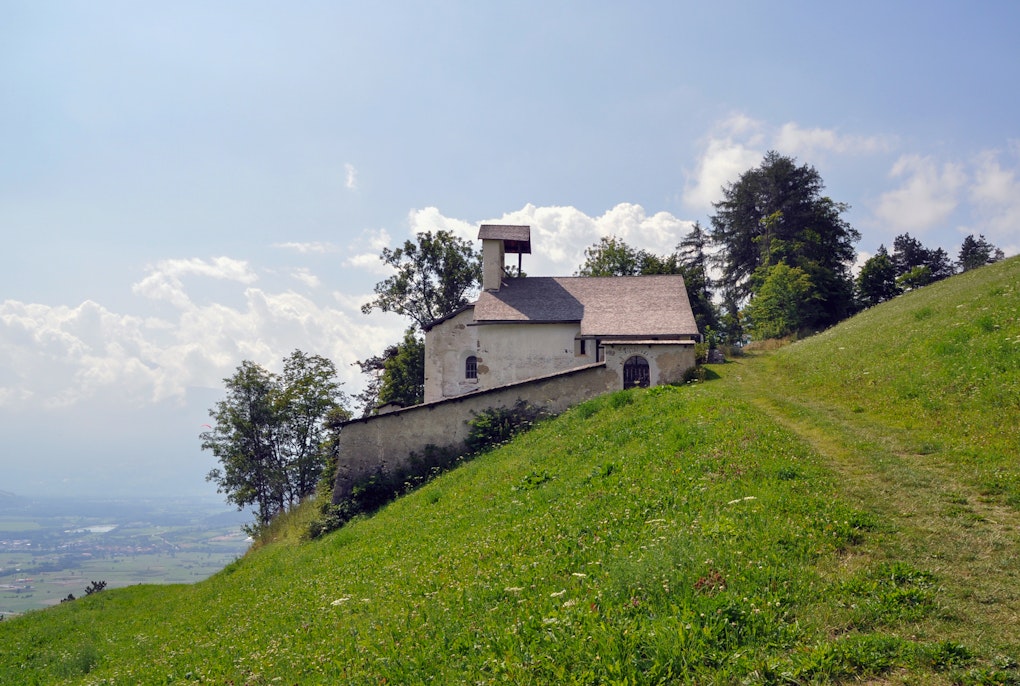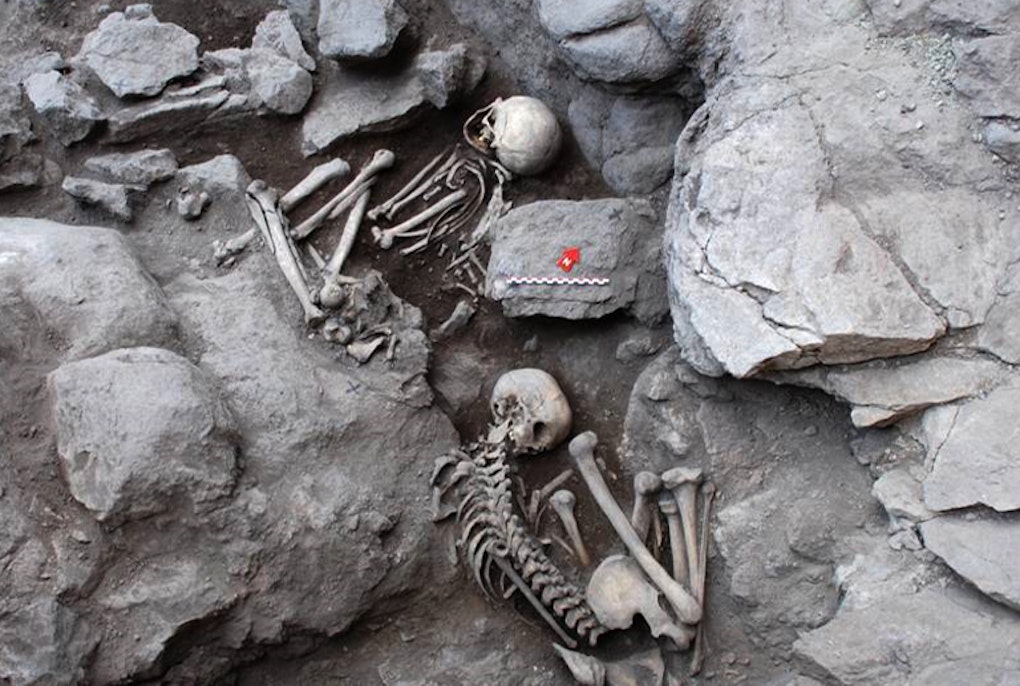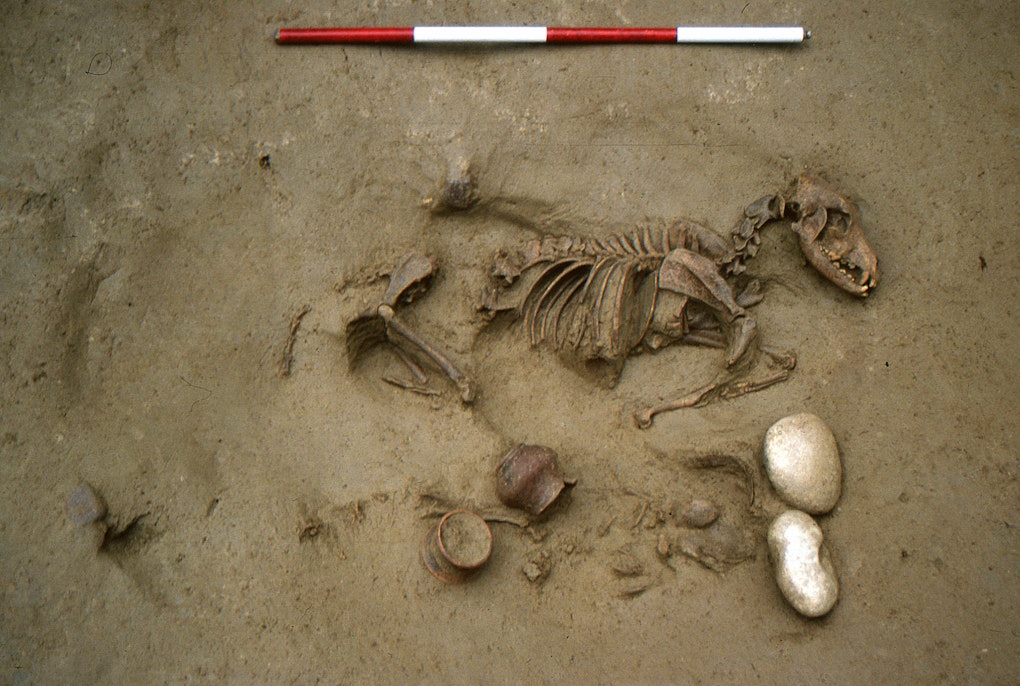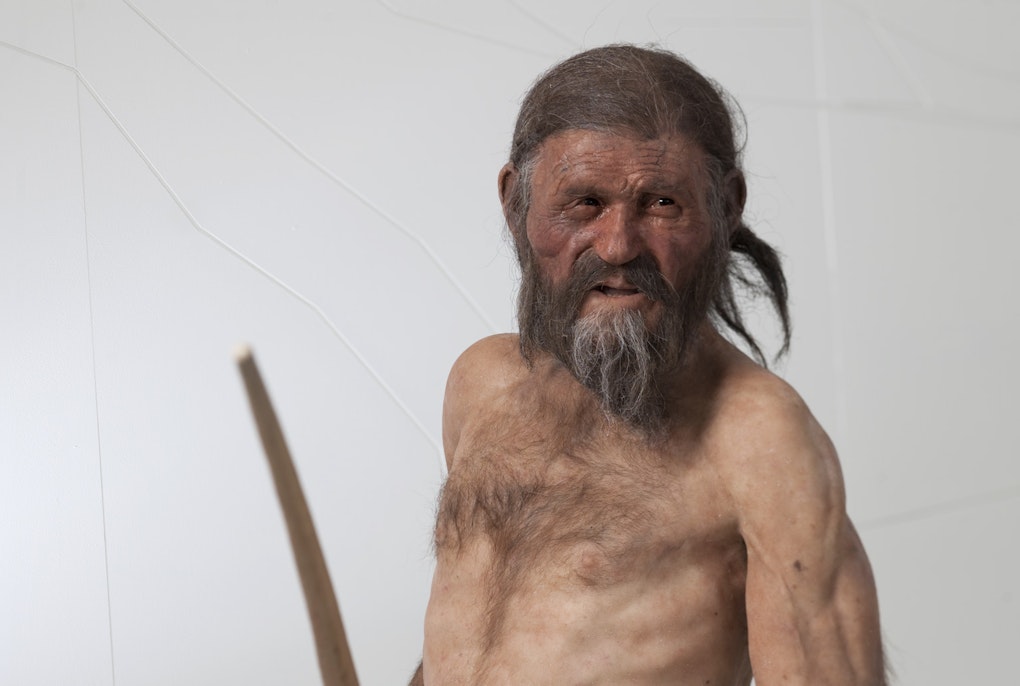magazine_ Article
The secrets of a lady from Basel
A well-preserved church mummy from the 18th century has proven to be a fascinating object of research in many respects
The hands of the mummy have been well preserved, like most of the body. Large folds of skin indicate the lady was overweight.
Photo: CC BY-SA 3.0 | All rights reserved
In 1975, a female mummy interred in the Barfüsserkirche in Basel, Switzerland was found. Her identity had for decades been a mystery until recently, with the help of genetic analyses, a research team from Eurac Research contributed decisively to unveiling her story. Who the lady was has now been revealed and, so have some further mysteries.
When construction work in the Barfüsserkirche in Basel in 1975 brought to light a tomb containing a well-preserved female mummy, only little was known with certainty: whoever the lady was - she was a somebody. Someone of rank, a woman of the upper class. Apart from the clergy, only the most important families had the privilege of finding their final resting place within the church walls. Initial examinations point in the same direction: around the small body - she is only 142 cm tall - her skin hangs in large folds, suggesting considerable corpulence; the well-preserved gall bladder is filled to bursting with stones. Everything speaks for the fact that the lady had in the course of her life, enjoyed plentifully both in fatty meats and desserts. Not the fare of the little people. An explanation for the mummification was also soon found: samples taken from the remains contained mercury in high concentration, which had apparently prevented decay. Mercury had been used in Europe for centuries to treat syphilis - a disease to which deformations on the mummy’s skull bones also seem to point.
But who was the woman? For decades, the mummy kept its secret, but in 2015, an interdisciplinary research team led by anthropologist Gerhard Hotz launched a new attempt to decipher it. Archives were combed through, burial registers, tombstone lists, funeral orations studied and a dedicated citizen science group in Basel transcribed hundreds of historical documents. Without success. At some point, however, the research would lead to a name and from that, perhaps even living descendants could be located for which a DNA comparison could then bring certainty. In this hope, Hotz turned to the Eurac Research Institute for Mummy Studies, one of the most renowned research institutions in Europe for the analysis of ancient DNA: the distinguished Institute had previously undertaken prominent investigations on Tutankhamun and Ötzi. On June 6, 2016, the head of the institute, Albert Zink, removed a premolar tooth from the mummy from the Barfüsserkirche.
There is a lot of DNA in human remains - but only a small part of it comes from the person in question.
"I then worked mainly with this tooth," explains molecular geneticist Christina Wurst, who has been working intensively on the Basel mummy in recent years. "After all, it is in the teeth and the petrous bone that you find the most endogenous DNA." Endogenous means this genetic material actually comes from the organism being studied, and in the complex DNA mixture found in human remains, it's something of a needle in a haystack. This is because more than 99 percent of the total DNA extracted may constitute "background contamination" - genetic material from microorganisms that colonized the organism while it was either alive or invaded it after death or could even be genetic traces from present-day humans who have come into contact with the remains. So, the first challenge for Christina Wurst was to extract enough of the lady's DNA from her tooth.
Wurst looked for genetic material of the mitochondria, the cellular power plants. Mitochondrial DNA is passed on exclusively from mother to child, making it much easier to trace family relationships. And the mitogenome has a further advantage for research purposes: unlike the nuclear genome, a cell can contain over a thousand copies of mitochondrial DNA. This is significant because ancient DNA tends to be in a poor condition - as soon as an organism dies, the long nucleotide chains begin to break down, and what can be extracted from bones, teeth, or soft tissue are often only small snippets. A high copy number increases the chance of finding enough fragments for sequencing, even if the DNA is very degraded.
In the Bozen-Bolzano laboratory, Wurst treated the tooth with a hypochloride solution and irradiated it with UV light to eliminate present contamination from the outer layers, then she ground it into a fine powder. To minimize the risk of contamination, laboratories for ancient DNA must comply with strict cleanroom regulations. Work surfaces and materials are treated with UV light and hydrogen peroxide, and researchers wear full body suits, face masks, gloves, and goggles - scientists can, however, subsequently bioinformatically identify old DNA by characteristic damage patterns, thus ensuring that a result has not been influenced by escaped researcher DNA. But an even bigger problem than contamination - "although of course that's a huge problem" - is fragmentation, Wurst says. "Sometimes we have fragments that are only 25 or 30 base pairs long" (nuclear DNA comprises more than three billion base pairs, mitochondrial DNA nearly 17,000). Fifteen years ago, there wouldn't have been much that could be done with such samples; scientific analyzes required fragments of at least 60 to 70 base pairs. But technology in this area has made spectacular progress; with Next Generation Sequencing, several hundred million fragments can now be sequenced simultaneously in one sample.
Wurst also used a special method to increase the proportion of mummy DNA in the sample, to "enrich" it so to speak. To do this, synthetically produced sequences of human DNA to which the small fragments of mummy DNA attach and can then be fished out with the help of a magnet, were added. Wurst explains: "The procedure is of course more complex, but that is the principle." The fished-out fragments are then amplified. "In the end, there is still background contamination, but the sample contains a much larger proportion of the genetic material we are interested in." Analysis of the mitogenome revealed that the lady belongs to a very old haplogroup that is now rare in Europe.
The lady certainly didn't die from syphilis but maybe from the treatment itself.
In the meantime, the hoped-for clue had turned up in Basel. A note from 1843, when the mummy had already been found and reburied, suggests, that a member of a well-known family from Basel, Anna Catharina Bischoff, born in Strasbourg in 1719 and who died in Basel in 1787, was our mystery woman. Finally, a candidate. The radiocarbon dating of clothing remnants and samples from her body fits, as does the age at death estimated from her joints. The task to find a female line which leads to present-day descendants followed. The pastor's wife had given birth to seven children, but only two daughters survived to adulthood; one of them remained childless, the other had three sons: the maternal line had been broken. But when the genealogists went back seven generations via Anna Catherina Bischoff's mother, grandmother, great-grandmother, etc., they finally arrived at an ancestor from the 16th century, from whom a female line actually lead to over 15 future generations, right up to the present day, to two aged siblings living in Basel. "Through meticulous work, the genealogists created a family tree representing over 200 people," Wurst says, impressed. (The research also revealed a relationship between the pastor's wife and Boris Johnson.) The siblings agreed to a DNA comparison, and saliva samples were taken for analysis.
The results confirm the hypothesis. The lady from the crypt and the Basel siblings share 25 identical gene alterations, including two gene mutations that occur in this combination very rarely. Theoretically, the match could also be coincidence, but this is 8,000 times less likely than a relationship, as a statistical analysis demonstrated. "And because everything fits together - the genetic, historical and genealogical results - we can truly assume that it is Anna Catherina Bischoff. The collaboration of the disciplines was key. "
The riddle of identity thus solved and an important result in several respects: for the first time, it has been possible to prove a relationship across 22 generations, which also confirms the potential of genetic analyses for historical research (similar analyses have revealed that a supposed descendant of Richard III was not his descendant at all, Wurst recounts). Moreover, with the identity, one now also knows the time and living conditions, and can relate further research findings to it - for the case is by no means closed. "The identification was just the first step," Wurst says. "We have also investigated much more." with Wurst herself researching Bischoff’s possible appearance. Unfortunately, genetic information in this regard is scanty, but it still managed to help to envisage certain aspects of the pastor’s wife - rendering her identity more concrete: "Dark hair, brown or green eyes, most likely freckles."
Another question that is being investigated is the cause of death. Did the pastor's wife really die of syphilis? The Basel research team was almost certain of this, and in 2016 asked the Bozen-Bolzano Institute to conduct another DNA study, this time to find genetic traces of the syphilis pathogen (background contamination in one study may be the focus of interest in another). "We examined a lot of tissue samples, from all parts of the body," explained microbiologist Mohamed Sarhan, "but we found no trace of the syphilis pathogen. The lady certainly didn't die from syphilis but maybe from the treatment itself. The mercury concentration in her brain was extremely high. In the past, mercury was used to treat many infections."
And here the researchers made an interesting discovery. In the sample from the brain, they found a lot of DNA from a bacterium of the genus Mycobacterium, so much that they were able to reconstruct the complete genome. A typical mycobacterium is the tuberculosis pathogen, but this was a nontuberculous mycobacterium - these germs are also commonly found in soil or water but can also actually cause pneumonia and other infections in immunocompromised people." Since analytical methods have improved in the clinic, it is being discovered more and more often that an infection caused by these bacteria is behind certain clinical pictures," explains Mohamed Sarhan. Comparing the bacterium discovered in the lady with today's strains can provide insights into developments and adaptations of pathogens.
Another stroke of luck and yet another bacterium: Helicobacter pylori which was found in Anna Catharina Bischoff’s stomach. This particular germ can lead to inflammation of the stomach lining and, if left untreated, cause stomach ulcers. The institute has already reconstructed its genome and is now investigating how it differs from the germ found in Ötzi, and how similar it is to that of modern Europeans. Christina Wurst is also continuing her research on the lady from Basel by including her findings in a large study on genetic predisposition to atherosclerosis, in which she has already analyzed Egyptian, Australian and South American mummies. Anna Catharina Bischoff had calcified vessels, and apparently diet was not the only culprit: in initial studies, Wurst was able to detect variants in various genes that are associated with an increased risk of atherosclerosis.
The research team in Basel had hoped to find letters or diaries from Anna Catharina Bischoff, but so far nothing has turned up. Perhaps the lady did not write, or if she did, her writings have not survived. Only her mummy can provide information. And questioned inquiringly, it tells a lot.
 technical documentation
technical documentationPublications
The research team details how the mummy's identity was confirmed by comparing its mitochondrial DNA with that of living descendants in a scientific paper published in Forensic Science International: Genetics: https://doi.org/10.1016/j.fsigen.2021.102604
A book for the general public describes the interdisciplinary search for clues around the mummy: Gerhard Hotz, Claudia Opitz-Belakhal (eds.). "Anna Catharina Bischoff. The Mummy from the Barfüsserkirche. Reconstruction of an 18th Century Women's Biography of Basel".
